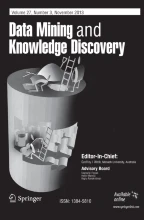Abstract
One fundamental problem of causal inference is estimating treatment eect with observational data where variables are confounded. The traditional way of controlling the confounding bias is to match units with different treatments but similar variables. However, traditional matching methods fail on selection and differentiation among the pool of numerous potential confounders, leading to possible under-performance. In this paper, we give a theoretical analysis of confounder differentiation and propose a novel Differentiated Matching (DM) algorithm for both individual and average treatment effect estimation by learning confounder weights for variable differentiation and unit matching. To address the distribution shift in confounder weights learning, we further propose a Propensity Score based DM (PSDM) algorithm by weighted regression with the inverse of the propensity score. Extensive experiments on both synthetic and real-world datasets demonstrate that the proposed algorithms achieve better performance than other matching methods on treatment effect estimation.
Similar content being viewed by others
Explore related subjects
Discover the latest articles, news and stories from top researchers in related subjects.Notes
The linear assumption can be relaxed by adding high order terms in the regression process.
Higher dimension brings NULL matching in DAME and CEM, we omitted these methods in continuous settings.
References
Austin PC (2011) An introduction to propensity score methods for reducing the effects of confounding in observational studies. Multivar Behav Res 46(3):399–424
Bottou L, Peters J, Quiñonero-Candela J, Charles DX, Chickering DM, Portugaly E, Ray D, Simard P, Snelson E (2013) Counterfactual reasoning and learning systems: the example of computational advertising. J Mach Learn Res 14(1):3207–3260
Chan D, Ge R, Gershony O, Hesterberg T, Lambert D (2010) Evaluating online ad campaigns in a pipeline: causal models at scale. In: KDD, pp 7–16
Dehejia RH, Wahba S (1999) Causal effects in nonexperimental studies: reevaluating the evaluation of training programs. J Am Stat Assoc 94(448):1053–1062
Diamond A, Sekhon JS (2013) Genetic matching for estimating causal effects: a general multivariate matching method for achieving balance in observational studies. Rev Econ Stat 95(3):932–945
Hill JL (2011) Bayesian nonparametric modeling for causal inference. J Comput Graph Stat 20(1):217–240
Holland PW (1986) Statistics and causal inference. J Am Stat Assoc 81(396):945–960
Iacus SM, King G, Porro G (2012) Causal inference without balance checking: coarsened exact matching. Polit Anal 20(1):1–24
Imbens GW, Rubin DB (2015) Causal inference in statistics, social, and biomedical sciences. Cambridge University Press, Cambridge
Kallus N (2017) A framework for optimal matching for causal inference. In: Artificial Intelligence and Statistics, pp 372–381
Kallus N (2019) Generalized optimal matching methods for causal inference. J Mach Learn Res (forthcoming)
Kohavi R, Longbotham R (2011) Unexpected results in online controlled experiments. ACM SIGKDD Explor Newsl 12(2):31–35
Kuang K, Cui P, Li B, Jiang M, Wang Y, Wu F, Yang S (2019) Treatment effect estimation via differentiated confounder balancing and regression. ACM Trans Knowledge Dis from Data (TKDD) 14(1):1–25
Kuang K, Li L, Geng Z, Xu L, Zhang K, Liao B, Huang H, Ding P, Miao W, Jiang Z (2020) Causal inference. Engineering 6(3):253–263
LaLonde RJ (1986) Evaluating the econometric evaluations of training programs with experimental data. Am Econom Rev pp 604–620
Lewis RA, Reiley D (2008) Does retail advertising work? measuring the effects of advertising on sales via a controlled experiment on yahoo! Measuring the Effects of Advertising on Sales Via a Controlled Experiment on Yahoo
Li Y, Kuang K, Li B, Cui P, Tao J, Yang H, Wu F (2020) Continuous treatment effect estimation via generative adversarial de-confounding. In: Proceedings of the 2020 KDD Workshop on Causal Discovery, PMLR, pp 4–22
Liu Y, Dieng A, Roy S, Rudin C, Volfovsky A (2019) Interpretable almost matching exactly for causal inference. AISTATS
Omohundro SM (1989) Five balltree construction algorithms. Int Comput Sci Institute Berkeley
Rosenbaum PR (2017) Imposing minimax and quantile constraints on optimal matching in observational studies. J Comput Graph Stat 26(1):66–78
Rosenbaum PR, Rubin DB (1983) The central role of the propensity score in observational studies for causal effects. Biometrika 70(1):41–55
Rosenbaum PR, Rubin DB (1985) Constructing a control group using multivariate matched sampling methods that incorporate the propensity score. Am Stat 39(1):33–38
Shalit U, Johansson FD, Sontag D (2017) Estimating individual treatment effect: generalization bounds and algorithms. In: Int Conf Mach Learn, PMLR, pp 3076–3085
Wang T, Morucci M, Awan MU, Liu Y, Roy S, Rudin C, Volfovsky A (2021) Flame: A fast large-scale almost matching exactly approach to causal inference. J Mach Learn Res 22:1–41
Zadrozny B (2004) Learning and evaluating classifiers under sample selection bias. In: Proceedings of the twenty-first international conference on Machine learning, p 114
Acknowledgements
This work was supported in part by National Natural Science Foundation of China (No. 62006207, No. 62037001), Young Elite Scientists Sponsorship Program by CAST (2021QNRC001), the Starry Night Science Fund of Zhejiang University Shanghai Institute for Advanced Study (SN-ZJU-SIAS-0010), Key R & D Projects of the Ministry of Science and Technology (2020YFC0832500), Project by Shanghai AI Laboratory (P22KS00111), Key Laboratory for Corneal Diseases Research of Zhejiang Province and the Fundamental Research Funds for the Central Universities (226-2022-00142).
Author information
Authors and Affiliations
Corresponding authors
Ethics declarations
Conflict of interest
The authors declare that they have no conflict of interest.
Additional information
Responsible editor: Sriraam Natarajan
Publisher's Note
Springer Nature remains neutral with regard to jurisdictional claims in published maps and institutional affiliations.
Rights and permissions
Springer Nature or its licensor (e.g. a society or other partner) holds exclusive rights to this article under a publishing agreement with the author(s) or other rightsholder(s); author self-archiving of the accepted manuscript version of this article is solely governed by the terms of such publishing agreement and applicable law.
About this article
Cite this article
Ziyu, Z., Kuang, K., Li, B. et al. Differentiated matching for individual and average treatment effect estimation. Data Min Knowl Disc 37, 205–227 (2023). https://doi.org/10.1007/s10618-022-00886-5
Received:
Accepted:
Published:
Issue Date:
DOI: https://doi.org/10.1007/s10618-022-00886-5
